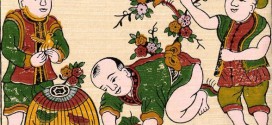The Vietnamese New Year, also known as Tet, is a time of joyous celebrations, vibrant decorations, and, of course, delicious food. In Vietnam, food plays a significant role in cultural traditions and is an essential part of welcoming the arrival of a prosperous new year. In this blog post, we will delve into the delightful world of Vietnamese New Year food, exploring its significance, popular dishes, and mouthwatering flavors. Join us on this culinary journey as we savor the essence of Tet through its delectable cuisine.
The Significance of Vietnamese New Year Food
Vietnamese New Year food holds deep cultural significance, symbolizing luck, prosperity, and the reunion of families. Each dish carries its unique meaning, reflecting the hopes and wishes for the upcoming year. As families gather around the dining table, they believe that consuming these traditional foods will bring good fortune and blessings. Let’s discover some of the most iconic dishes enjoyed during this festive season.
Traditional Vietnamese New Year Dishes
Banh Chung and Banh Tet
Banh Chung and Banh Tet are iconic Vietnamese New Year dishes. These sticky rice cakes symbolize the Earth and the Sky, respectively, representing the harmony between humans and nature. Banh Chung is a square-shaped cake made of glutinous rice, mung bean paste, and pork, wrapped in banana leaves. Banh Tet, on the other hand, is cylindrical and often filled with ingredients like banana or sweet mung bean paste. Both are meticulously prepared and steamed for hours, resulting in a savory and aromatic delicacy.
Mut (Candied Fruits)
Mut, or candied fruits, are an essential part of Vietnamese New Year traditions. These vibrant, sweet treats come in various forms, including dried fruits, preserved ginger, coconut, lotus seeds, and more. Mut is believed to bring good luck and fortune for the coming year. It is customary to serve Mut in colorful trays as a delightful snack for guests, adding a touch of sweetness and joy to the festivities.
Gio Cha (Vietnamese Sausage)
Gio Cha, a type of Vietnamese sausage, is a popular dish during Tet. It is made from ground pork mixed with various spices, including garlic, pepper, and fish sauce. The mixture is tightly packed into banana leaf molds and boiled until firm. Gio Cha is typically sliced and served as a savory appetizer or alongside other festive dishes. Its rich flavors and unique texture make it a beloved addition to Vietnamese New Year feasts.
Xoi (Sticky Rice)
Xoi, or sticky rice, holds a special place in Vietnamese cuisine, particularly during Tet. This versatile dish is prepared by steaming glutinous rice and can be served in different variations. Xoi Gac features vibrant red sticky rice, naturally colored by Gac fruit, and is believed to bring good luck. Xoi Lac combines sticky rice with roasted peanuts, offering a delightful blend of sweet and savory flavors. Other variations include Xoi La Cam (magenta leaf sticky rice) and Xoi Ngo (corn sticky rice), each with its unique characteristics and tastes.
Embrace the Flavors of Vietnamese New Year Food
As Vietnamese families come together to celebrate the New Year, the aroma of these traditional dishes fills the air, creating a warm and inviting atmosphere. Vietnamese New Year food not only satisfies the palate but also nourishes the soul, fostering a sense of unity and cultural identity.
Whether it’s the savory Banh Chung, the delightful Mut, the flavorful Gio Cha, or the comforting Xoi, each dish tells a story and encapsulates the spirit of Tet. So, embrace the flavors, gather with loved ones, and indulge in the culinary delights that the Vietnamese New Year has to offer. May the coming year be filled with joy, prosperity, and an abundance of delicious food!
 Vietnamese Culture and Tradition
Vietnamese Culture and Tradition 


